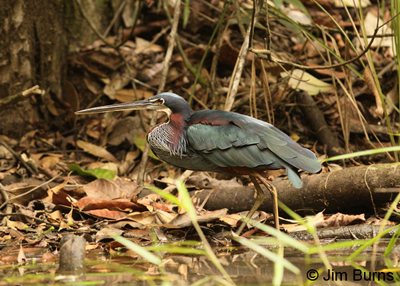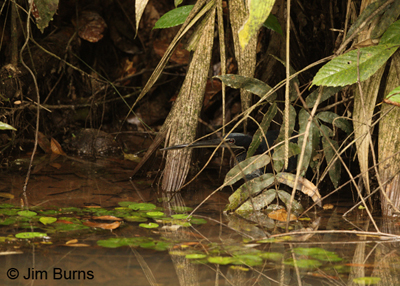
Didier and Sangnutz are in the first canoe. Steven and I are a few yards behind them, working slowly through dark waters overhung with jungle vegetation and mined with submerged branches. We are on an oxbow of the San Carlos River at Laguna del Lagarto Lodge near Pital, Costa Rica. Our goal is a glimpse of Agami Heron, a shy, retiring, uncommon, and local heron sometimes described as the most beautiful member of its family in the world. Steven, an ex-pat American who is fluent in Spanish and all things to do with Costa Rican birds, is hopeful. I am coming out of my skin but trying to remain calm, always a good idea when sitting in a canoe inches above the waterline balancing camera equipment on your lap.
Didier, a local guide has seen an Agami here off and on in recent days. Sang, the proud owner of a large white telephoto lens, is his client. I’ve privately attached the meant-to-be-endearing suffix to Sang’s name because though wildly enthusiastic, that enthusiasm seems to outrun his competency with both camera and Costa Rican avifauna as he sits around the lodge veranda waiting for Didier to find birds for him, and then carry his lens and backpack for him on the trails.
We are on the Caribbean slope of Costa Rica, it is early morning, and the sun is cloud hopping. It could rain at any moment, which adds immeasurably to the tension and drama of the moment—rare, hard to find, harder to see well bird, deep shadows, extreme expectation and excitement heightened by the slow progress and intense focus required of our mode of transportation—the ying and yang of birding at its best.
At the very moment the rain hits, as we scramble for garbage bags to cover cameras, Didier spots the Agami 20 yards out on the left shoreline under overhanging branches. Sang raises his binoculars, gets his glimpse, then calls for them to turn back to get out of the rain. The Agami backs up two steps and melts into the forest, perhaps alarmed by the slight commotion, perhaps simply to get out of the rain. Steven and I drift, wet and wordlessly, toward the left shore and stall the canoe against a log.
As the brief squall passes and sunlight again dapples the forest clearings, the Agami drops from a branch directly in front of us, oblivious to the canoe. We watch spellbound and speechless as it works the shoreline, in and out of the shadows in hunting heron mode, perhaps a step or two every five minutes. Many images are made. Though we will see many birds with more spectacular colors and more remarkable shapes, Agami is the bird of the trip. It is easier to find farther south, but here in Costa Rica it has mythical status best recognized by the fact that knowledgeable birders simply refer to it as “Agami” and never add the “heron.”
“Agami” is an American Indian name meaning “forest bird.” Known in some parts as Chestnut-bellied Heron, it is a medium-sized heron reminiscent of our Tricolored and about that size but with shorter legs and a much longer rapier of a bill. The neck and belly are deep, rich chestnut, the chest a light slaty blue adorned with white plumes. The eyes are amber, the head black with soft blue crest feathers, the throat and full length central neck stripe ecru. The scapulars are tinged chestnut, but the wings and mantle are a kaleidoscope of soft, glossy, iridescence, artichoke green in the sun, muted, slaty gray-green in the shadows where the bird spends most of its time. Subtly spectacular, this is a bird perfectly plumaged for its niche on the planet.
We return to find Sang at his computer on the veranda. We have just had half an hour of face time with one of the country’s most difficult to find birds. Sang had a ten second glimpse. Even Steven, with years of Costa Rica guiding on his resume, is highly pleased with our morning. We have no idea what to say to Sang, so we go directly to our rooms to download our images of the bird of the trip. We’ll show him if he asks.
